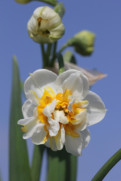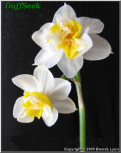

Unknown
UnknownCorona yellow-orange. Sweetly scented.
According to a research paper by Jaminia A. Colliard, titled “Little Cups of Gold: The History of Cultivation of Tazetta Narcissus, she writes: “This variety is scattered in cow pastures and along old roads was brought to Northern California area by Chinese immigrants during the Gold Rush and is called Single Chinese or Chinese Sacred Lily. The flowers are used in the Chinese New Year’s Celebrations and are considered sacred. It is believed that the Single Chinese Narcissus were spread East by the Silk Route, since the flowers are found growing all along it. They also grow along the coasts and rivers of China, possibly being spread by traders or perhaps by floods.”
Estimating an RHS registration date of 1889 for this daffodil.
According to a research paper by Jaminia A. Colliard, titled “Little Cups of Gold: The History of Cultivation of Tazetta Narcissus, she writes: “The reference to Rome comes from the fact that the varieties are believed to be native to the Mediterranean area and were actually spread to surrounding areas of the Mediterranean by Roman soldiers, hence the name “Double Roman”. Apparently, the bulbs help relieve muscle pain and are so poisonous they were used to end the life of suffering soldiers who were wounded badly and going to die. This same poison is what keeps gophers and deer from eating them.”
'Constantinopolitanus', 'Double Chinese', 'Double Italian', 'Double Marsellian', 'Double Roman', 'Double White Polyanthus', 'Double White Sweet Scented', 'Flore Multiplici', 'Italicus Plenus', 'Old Italian', 'Roman', 'Tazetta 'Flore Pleno'', 'Tazetta 'Romanus'', 'The Double Roman Narcissus'
 Romanus, 4 W-O, Unknown Hybridizer, 1889
Romanus, 4 W-O, Unknown Hybridizer, 1889
Photo #51105 Kirby Fong, USA Romanus, 4 W-O, Unknown Hybridizer, 1889
Romanus, 4 W-O, Unknown Hybridizer, 1889
Photo #48231 Henry Shejbal, Italy Romanus, 4 W-O, Unknown Hybridizer, 1889
Romanus, 4 W-O, Unknown Hybridizer, 1889
Photo #41485 Kirby Fong, USA Romanus, 4 W-O, Unknown Hybridizer, 1889
Romanus, 4 W-O, Unknown Hybridizer, 1889
Photo #41484 Kirby Fong, USA Romanus, 4 W-O, Unknown Hybridizer, 1889
Romanus, 4 W-O, Unknown Hybridizer, 1889
Photo #41483 Kirby Fong, USA Romanus, 4 W-O, Unknown Hybridizer, 1889
Romanus, 4 W-O, Unknown Hybridizer, 1889
Photo #18183 Barr Catalog, England Romanus, 4 W-O, Unknown Hybridizer, 1889
Romanus, 4 W-O, Unknown Hybridizer, 1889
Photo #15267 Brenda Lyon, Australia Romanus, 4 W-O, Unknown Hybridizer, 1889
Romanus, 4 W-O, Unknown Hybridizer, 1889
Photo #7866 Linda Van Beck, USA Romanus, 4 W-O, Unknown Hybridizer, 1889
Romanus, 4 W-O, Unknown Hybridizer, 1889
Photo #2643 Kirby Fong, USA Romanus, 4 W-O, Unknown Hybridizer, 1889
Romanus, 4 W-O, Unknown Hybridizer, 1889
Photo #2642 Kirby Fong, USA Romanus, 4 W-O, Unknown Hybridizer, 1889
Romanus, 4 W-O, Unknown Hybridizer, 1889
Photo #752 Ben Blake, USA
![]()